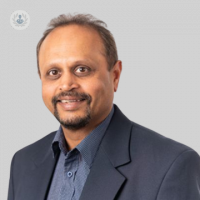Knee ligament injuries: An expert guide
Written by:Ligaments are tough, flexible bands of tissue that connect bones to other bones, providing stability and support to a joint. A knee ligament injury, which is one of the most serious types of injuries, involves damage to one or more of the ligaments in the knee joint.
Here, Mr Sanjiv Manjure, renowned consultant orthopaedic surgeon, offers his expert insight into knee ligament injuries.

What are the most common causes of knee ligament injuries?
Knee ligament injuries typically result from sudden twists, blows, or impacts on the knee.
The most common causes include:
- Sports injuries: High-impact sports that involve sudden stops, changes in direction, or direct blows to the knee can lead to ligament injuries. Football, basketball, and skiing are prime examples.
- Traumatic accidents: Motor vehicle accidents or falls can cause significant force on the knee, leading to ligament damage.
- Overuse or repetitive stress: Engaging in repetitive activities that strain the knee, such as running or jumping, can contribute to ligament injuries over time.
What are the signs and symptoms of a knee ligament injury?
Recognising the signs and symptoms of a knee ligament injury is crucial for early intervention.
The most common signs and symptoms include:
- Pain and swelling: Immediate pain and swelling around the knee joint are common symptoms of ligament injuries.
- Instability or weakness: A feeling of instability, giving way, or weakness in the knee can indicate ligament damage.
- Limited range of motion: Difficulty bending or straightening the knee can indicate a ligament issue.
- A popping sound: Hearing a popping or snapping sound at the time of injury can indicate a ligament injury.
How are knee ligament injuries diagnosed?
Accurate diagnosis is essential for determining the most appropriate course of treatment.
Diagnosing knee ligament injuries involves:
- A clinical examination: A complete physical examination to assess symptoms, range of motion, and stability.
- Imaging tests: X-rays, MRI scans, or ultrasound scans to visualise and assess the extent of ligament damage.
What are the available non-surgical treatment options for knee ligament injuries?
Non-surgical treatment options include:
- RICE: Rest, ice, compression, and elevation can help reduce swelling in the initial stages of the injury.
- Bracing or splinting: Supportive braces or splints can provide stability and promote healing.
- Physical therapy: Targeted knee exercises can strengthen the surrounding muscles and improve range of motion.
When is surgery required for a knee ligament injury?
Knee ligament surgery may be considered for severe ligament injuries or for cases where non-surgical treatment methods are ineffective.
In most cases, surgery is performed under general anaesthesia using arthroscopic (minimally invasive) surgical techniques, which involve making small incisions through which a tiny camera (arthroscope) and surgical instruments are inserted.
Using the arthroscope, the surgeon will then examine the inside of the knee joint to assess the damaged ligament(s) and identify any associated injuries.
If ligament reconstruction is required, the surgeon will harvest an autograft (a piece of tissue) to replace the damaged ligament. Common graft sources include the patellar tendon, the hamstring tendons, or donor tissue (allograft). The surgeon will use this graft to reconstruct the damaged ligament, which involves securing the graft in place using screws, staples, or other fixation devices.
The surgeon will then ensure that the reconstructed ligament provides stability to the knee joint. Lastly, the incisions will be closed, and a sterile dressing will be placed over them.
Following surgery, when will I be able to return to normal activities, including sports?
Following knee ligament surgery, the knee will be placed in a brace or cast to limit movement and promote healing.
Physical therapy is an essential part of postoperative care. The patient will work with a physiotherapist to gradually regain strength, flexibility, and range of motion in their knee.
The timeline for returning to normal activities, including sports, will vary for each patient. Regular follow-up appointments with the surgeon are essential to monitor progress, address any concerns, and make necessary adjustments to the rehabilitation plan.
If you suspect a knee ligament injury, don’t hesitate to book an appointment with Mr Sanjiv Manjure via his Top Doctors profile today.


